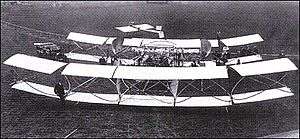Seddon Mayfly
| Seddon Mayfly | |
|---|---|
 | |
| Role | Experimental aircraft |
| Manufacturer | Accles & Pollock, Oldbury |
| Designer | Lieutenant John Wilfred Seddon, A G Hackett |
| Number built | 1 |
|
| |
The Seddon Mayfly was a tandem biplane of unusual construction. It was designed by Royal Navy Lieutenant John W. Seddon and A. G. Hackett[1] and built by Accles & Pollock. When built it was the largest aeroplane in the world,[2] but it failed to fly when tested.
Design and development
Design of the Seddon Mayfly began in 1908, with the intention of attempting to win the prize for a flight between Manchester and London given by the Daily Mail. The design was based on a paper model, and Seddon took leave from the Navy to design and build and test the aircraft.[3] It was built in Oldbury by Accles & Pollock, a company who specialised in the manufacture of steel tubing, and its structure made extensive use of intersecting pairs of steel hoops: over 2,000 ft (610 m) of steel was used in its construction [2] The aircraft had two sets of biplane wings, the front pair of greater span than the aft pair. Control surfaces consisted of a forward-mounted biplane elevators and a pair of diamond-shaped rudders mounted between each set of wings. The aircraft was intended to carry five passengers in addition to the pilot.

It was powered by a pair of 65 hp (48 kW) N.E.C. water-cooled engines mounted side by side between the two sets of wings. Each drove a single Beedle type tractor propeller. These were made of sheet aluminium, with the semi-circular blades supported at the ends by attachment to a radial tube.[4]
It was tested at the Midland Aero Club grounds at Dunstall Park near Wolverhampton [5] but damaged an axle[6] and failed to leave the ground. It was eventually taken apart by souvenir hunters.
Specifications
General characteristics
- Crew: 1
- Capacity: 5
- Length: circa 50 ft (15.20 m)
- Wingspan: circa 50 ft (15.20 m)
- Height: ()
- Wing area: 1,000 sq ft[7] (93 sq m)
- Loaded weight: 2600 lb (1180 kg)
- Powerplant: 2 × NEC six-cylinder water-cooled piston engine, 65 hp (48kW) each
Performance
References
- ↑ The Seddon AeroplaneFlight 10 September 1910, p.734
- 1 2 Lewis 1962 p.432
- ↑ Dunstall Park Flight 5 November 1910, p.908]
- ↑ Aerial PropellersFlight 15 January 1910
- ↑ Dunstall park Flight 5 November 1910]
- ↑ Dunstall Park Flight 19 November 1910]
- ↑ The Seddon AeroplaneFlight 10 September 1910, p.734
Bibliography
- Lewis, P., British Aircraft 1809-1914. London: Putnam, 1962
- Winchester, Jim. The World's Worst Aircraft. United States, NY: Metro Books, 2005. ISBN 0-7607-6742-4